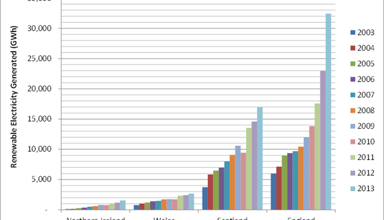The report of an independent review of UK tidal lagoon energy was published on 12 January 2017 by a former UK energy Minister Charles Hendry. The report praises the proposed ‘pathfinder’ tidal lagoon in Swansea Bay as a ‘no-regrets option’, and sets out a supportive case for developing the sector.
The Hendry Review was commissioned in February 2016 by UK Government to assess the strategic case for tidal lagoon energy as a new industry in the UK. This followed a successful planning proposal by Tidal Lagoon Power (TLP) to develop the world’s first tidal lagoon in Swansea Bay, as well as a subsequent programme for a ‘fleet’ of five larger projects, including three in Welsh waters (Cardiff, Newport and Colwyn Bay).
Despite the Swansea Bay project appearing in the 2015 UK Conservative Party manifesto and receiving development consent in June 2015, uncertainties around cost and subsidy subsequently prompted the UK Government to commission an independent review. Its aim was to examine the ability of tidal lagoon energy to cost-effectively contribute to the UK’s energy mix, and the level of subsidy required to do so.
Tidal lagoons generate electricity by enclosing an area of sea adjacent to coastline with a sea wall, and capturing the energy from the rise and fall of tides using turbines. A number of lagoon projects in Wales have been proposed due to the significant tidal range along the Welsh coastline - particularly in the Severn Estuary, which has the second largest range in the world.
The case for tidal lagoon energy in Wales
The Hendry report (PDF, 2.72MB) highlighted the predictability of electricity output and extremely low carbon emissions (less than 20 grams of CO2 equivalent per kWh – on par with onshore wind and nuclear) as major advantages of tidal lagoons. Moreover, a lagoon’s estimated operating lifetime of 120 years or more is unparalleled by any energy technology. In combination, the Review found that they could make a strong contribution to UK energy security and decarbonisation targets. TLP estimate that their fleet of lagoons could supply 8% of future UK electricity demand.
According to the report, the potential benefits to Welsh economy are significant, and there have been many expressions of support from Assembly Members on a cross-party basis. The Review found that the Swansea Bay project would bring ‘very real and substantial economic and recreational benefits’ to the area (p.37) – drawing upwards of an estimated 70,000 tourists per year (p.51) – as well as wider economic benefits across the country.
Supply chain development and employment opportunities are thought to be considerable; TLP told the Review that over 1000 UK businesses have registered an interest in supplying parts and skills to the Swansea Bay project, and the company is aiming to source 50% of the materials and components from Wales. Many companies – including from within the steel sector – described the potential TLP programme as a ‘lifeline’ for their operations (p.47).
Rise and fall: project costs
With construction costs of £1.3 billion, there were fears that the 320 megawatt (MW) Swansea Bay project would not be cost effective for bill payers. Under the ‘Contracts for Difference’ (CfD) scheme, it was initially estimated that the ‘strike price’ - the guaranteed price needed for the sale of its electricity - would be more expensive than, for example, nuclear power from Hinkley Point C, and this would be met in part through increased consumers’ bills.
However, such costs were calculated on the basis of a 30-year model. As highlighted by the report, key economic characteristics of lagoons are low operation costs, and an ability to spread total costs across the very long operating life. When pricing over a longer 60- or 90-year CfD model, tidal lagoon energy becomes much more competitive. Swansea Bay, it concludes, would cost each Welsh household 30 pence per year, for 30 years, and could potentially be subsidy-free after 60 years (p.75). As a pathfinder lagoon, it is projected to bring about large cost reductions for any subsequent projects, making them very competitive with other low carbon technologies over project lifetimes.
Looking ahead
The Review is clear in its support of developing a small-scale project in Swansea Bay ‘as soon as reasonably practicable’ (p.91), calling it a ‘no-regrets’ policy (p.89), and encourages the UK Government to build upon the progress it has made with TLP to move towards a final stage negotiation. TLP is also awaiting a marine licence from Natural Resources Wales.
A key recommendation in the report was that the Swansea Bay lagoon should be operational for a reasonable period before construction commences on any large-scale projects, so that the full range of impacts can be monitored over time. This is in part a response to environmental concerns over potential lagoon impacts on marine habitats and species, which carry considerable uncertainties that stem from the technology’s infancy.
To help maintain the supply chain during such a ‘pause’, the report calls for the development of a series of small-scale lagoons between larger projects. The Cabinet Secretary for Economy and Infrastructure said in Plenary on 25 January 2017 that the Welsh Government is working with local government, skills providers and businesses to identify opportunities to maintain a constant pipeline of projects.
There have been expressions of interest by the Welsh Government in taking a stake in the Swansea Bay project, and Plaid Cymru have proposed a not-for-profit public energy company as a suitable organisation for doing so. A Welsh Government Debate will take place on 14 February 2017 to discuss these proposals, as well as the Review’s findings, in detail.
The UK Government will respond to the Review’s findings after it has assessed the report’s recommendations.
The Research Service acknowledges the parliamentary fellowship provided to Jack Miller by the University of Sussex, which enabled this blog post to be completed.
Article by Jack Miller, National Assembly for Wales Research Service






